Autoflowers are a special type of cannabis which will automatically flower about 3-4 weeks after germination, and without the need for the light schedule to change to 12/12. Show more…
Banana Purple Punch Auto
Gorilla Zkittlez Auto
Purple Punch Auto
Cherry Cola Auto
Strawberry Gorilla Auto
Gorilla Punch Auto
Forbidden Runtz Auto
Kosher Cake Auto
Mimosa Cake Auto
Strawberry Banana Auto
Wedding Glue Auto
Amnesia Zkittlez Auto
Blueberry Auto
Afghan Kush Auto
Big Bud Auto
Cinderella Auto
Trainwreck Auto
Strawberry Pie Auto
Lemon Pie Auto
Wedding Cheesecake Auto
Amnesia Haze Auto
Zkittlez Auto
Orange Sherbet Auto
Buy Autoflowering Cannabis Seeds
Growers of all skill levels are increasingly finding that autoflowering cannabis seeds are the best option. Because of our commitment to generating the best possible genetics in our autoflowering seeds and making sure that strains can produce amazing yields in fewer than 9 weeks, we at Fast Buds take great satisfaction in being recognized as one of the most reputable cannabis seed banks in the industry. Auto-flowering varieties provide auto-growers a number of benefits in addition to their rapid blooming time, including the following:
- Genetic fortitude: in comparison to its counterpart, autoflowering seeds possess genetic fortitude that enables them to withstand less-than-ideal circumstances and withstand pests with relative ease.
- Autoflowering strains tend to stay on the shorter side, reaching a maximum height of 100 centimeters in most cases. Because of this, they are an excellent choice for growers who wish to keep their operations as covert as possible.
- Quick flowering: The majority of autoflowering genotypes require only seven to ten weeks from seed to harvest, which enables gardeners to produce many crop cycles when compared to photographs.
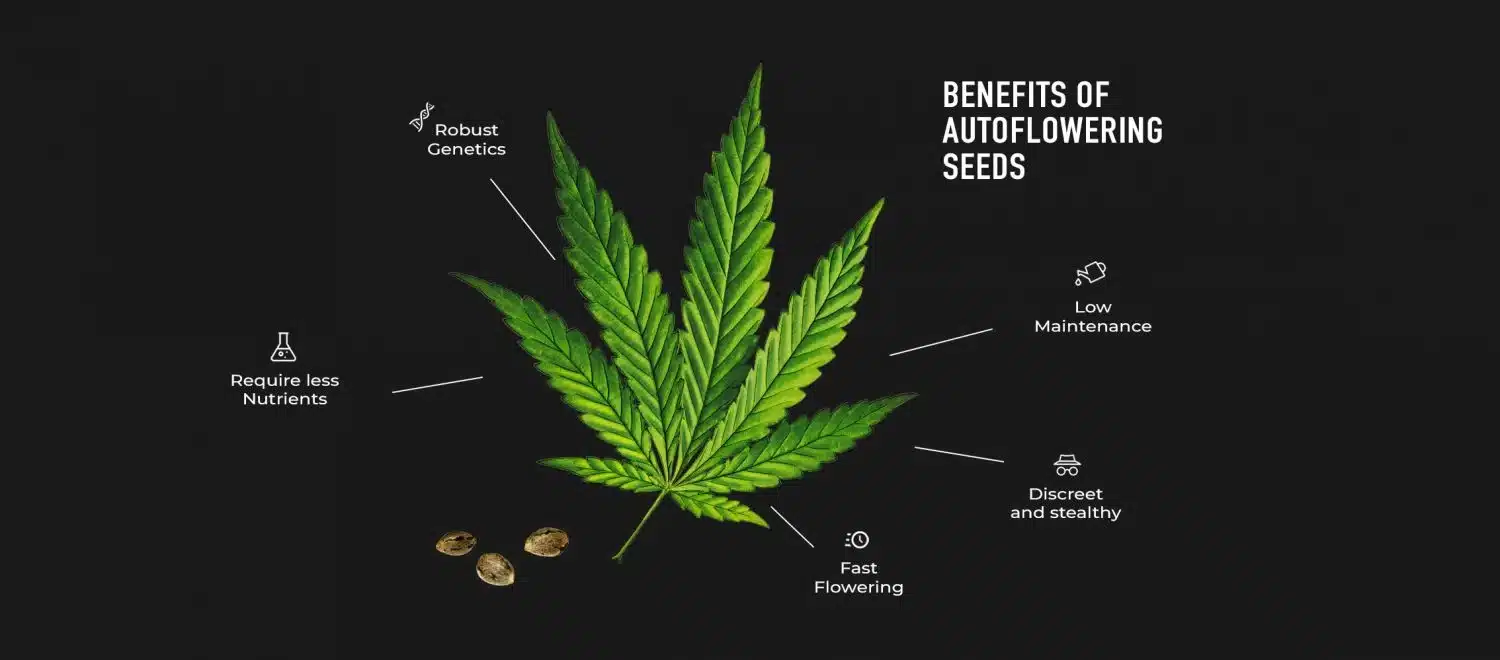
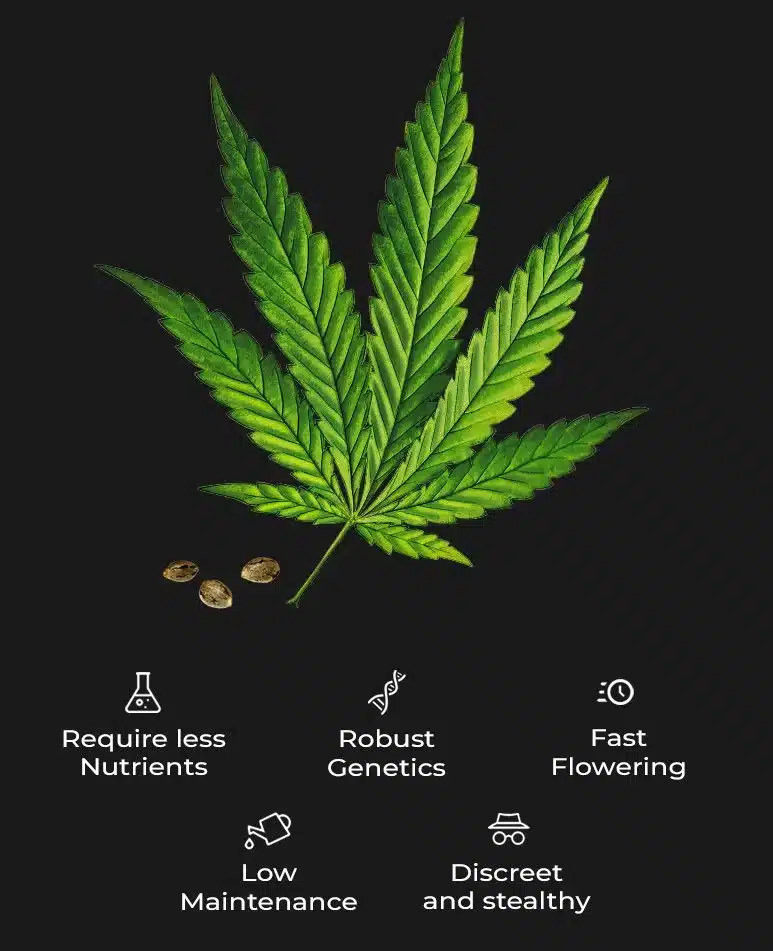
Why Should You Go for Fast Buds?
It is possible to develop more quickly. Fast Buds' strains have been developed over the course of many years. We have invested a significant amount of time into our genetics, searching for the characteristics that customers want the most. Through extensive research and breeding, we were able to select and improve the strains that were already at the top of their game. The flavor, scent, and impact of our plants are where you can truly appreciate all of our hard work over the years. We provide a diverse range of strains for purchase in the United States, each of which possesses a unique combination of qualities and attributes. These strains are designed to meet the needs of a wide range of customers, from novice to experienced cultivators, and are available in large quantities. You may select the ideal strain for you online, and it will be delivered to your door discretely and quickly using an expedited shipping service.
Where Can I Buy Cannabis Seeds That Automatically Flower?
Getting your hands on some weed seeds that self-seed is a breeze. The first thing you need to do is go to seedsplug.com and browse through our product catalog; once you have decided which strains you want to purchase, choose the five-seed pack size, and then choose how you would like to make payment; After picking your favorite mode of payment from among Bitcoin, Visa/Mastercard, PayPal, Zelle, CashApp, Venmo, and Cash, all that's left to do is wait a few of days for your item to arrive!
How many autoflowering seeds can I buy at once, and how much does each one cost?
If you are a regular homegrower, you probably won't need a lot of feminized seeds. Because of this, we give you the option to buy cannabis seeds in packs that contain only 5 cannabis seeds. However, if you grow weed outdoors or have a large indoor grow space, it may be more beneficial to buy weed seeds in larger quantities. Because of this, we give you the option to buy cannabis seeds in bigger packs that contain 100 marijuana seeds, all of which can be shipped in a single pack
How could one go about selecting the very finest feminized seeds?
Because there are hundreds of autoflowering genotypes on the market, and each one has distinctive qualities that will appeal to certain customers but not others, we've included a filter to make it simpler for you to select cannabis seeds for your subsequent grow cycle. The results of your search may be categorized by "high price," "low price," and "bestsellers," making it possible for you to locate exactly what it is that you're searching for. Our online catalog has a number of genetics that can be filtered, for instance, by "temperature," "size," and "strength." When you buy cannabis seeds in this method, you know precisely what you will get in return.
Are There Any Autoflowering Seeds That Aren't Fertile?
Your autoflowering cannabis seeds will generate 100 percent feminized seeds, meaning that none of them will form pollen sacs but will instead produce seedless blooms. This is because all of the autoflowering genetics that we sell in our catalog are feminized. If you want to get the best results possible, we recommend paying attention to the following factors: Nevertheless, it is highly recommended that you provide good growing conditions in order to maximize the results. This is because the growing conditions can affect both the quality and quantity of your harvest.
- NPK levels. Remember that autoflowering marijuana loves greater levels of Nitrogen during the vegetative stage and increasing levels of Phosphorus and Potassium during the flowering stage. Getting the appropriate amounts of Nitrogen, Phosphorus, and Potassium at the right period will undoubtedly optimize your yield.
- The relative humidity and degree of moisture. In order for seedlings to develop without experiencing any difficulties, it is advised that the humidity level be somewhere about 70 percent. In addition, the substrate should constantly be moist but not entirely wet.
- Temperatures. Temperatures should be adjusted appropriately for each stage of plant development, beginning at around 20-25 degrees Celsius for seedlings, moving up to 22-28 degrees Celsius during the vegetative stage, and ending at 18-24 degrees Celsius during the blooming stage.
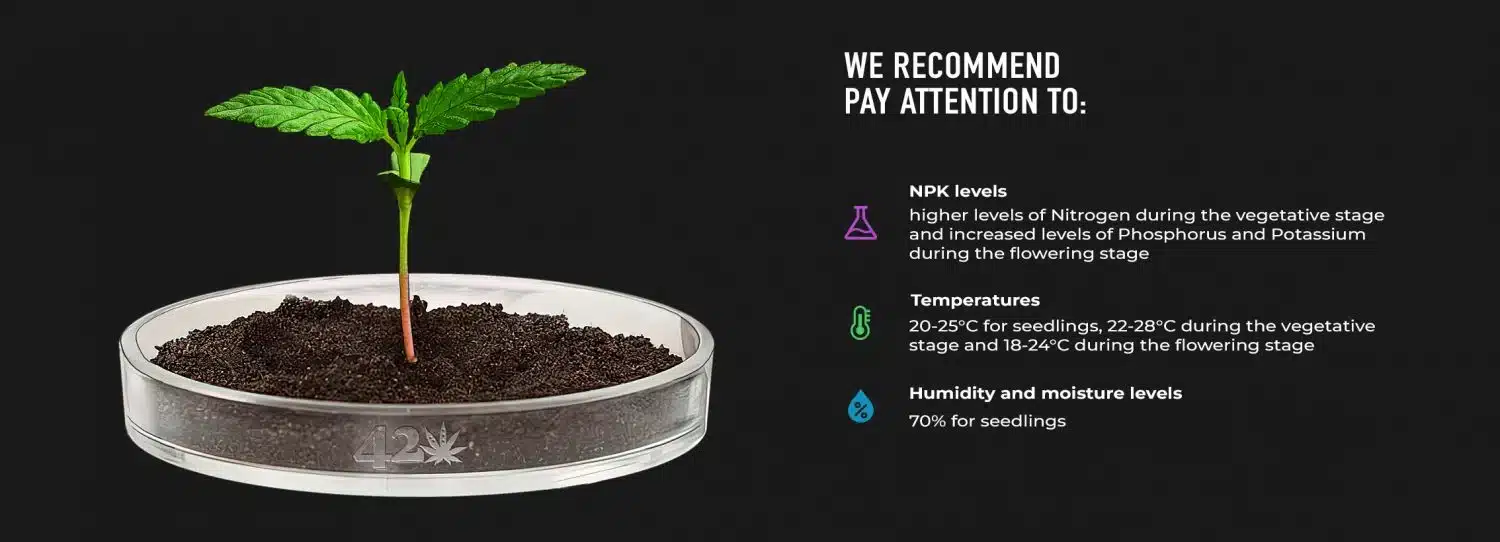

Why Should You Opt To Buy Cannabis Seeds That Flower On Their Own?
Cannabis seeds that blossom on their own have a number of advantages over ordinary genetics that set them apart from the competition. Among these advantages, the following are particularly noteworthy:
- Low-maintenance: because these kinds of plants mature rapidly and remain healthy, there is typically no need to provide further care unless it is absolutely necessary.
- Because they are grown for shorter periods of time and for shorter durations, cars require less nutrients, which ultimately results in you saving both time and money.
- Due to the fact that autoflowering plants tend to grow on the shorter side, it is possible to cultivate them in relatively tiny grow tents or in areas with limited space, such as balconies or terraces.
Growing cannabis at home for one's own use might be one of the most satisfying pastimes for people who use marijuana for recreational purposes and are also enthusiastic about the plant. Regrettably, classic non-autoflowering cannabis strains can be challenging to develop, even for those with greater expertise growing cannabis. When you buy cannabis seeds from Fast Buds, you get access to a wide variety of autoflowering strains, as well as our originals line, which are known for their quick growth.
- Amnesia Haze Auto
- Northern Lights Auto
- OG Kush Auto
- AK Auto
- Cheese Auto
- Jack Herer Auto
- White Widow Auto
- Sour Diesel Auto
- Chemdawg Auto
- Gorilla Cookies Auto
- Lemon Pie Auto
- Strawberry Pie Auto
- Wedding Cheesecake Auto
- Orange Sherbert Auto
Because of how our genetics have been optimized, your Fast Buds auto seeds will not only be ready to harvest in just nine weeks, but they will also be hardy enough to develop successfully both indoors and outside. Our clients come from all over the world, and regardless of the environment where they live, they discover that autoflowering seeds provide the best answer for cultivating their own cannabis. Since our professional team developed the optimal autoflowering genetics that are required to generate stunning strains, they have been working on merging these into the most famous strains in the cannabis industry. As time has gone on, we have also optimized for high quantities of THC, and as a result, customers who buy autoflowering marijuana seeds from us receive a robust final product that, when smoked, produces an exceptional degree of high.
How Are Autoflowering Seeds Created?
Anyone who has experience growing plants in the past, even if they haven't produced cannabis, may easily master the science of making autoflowering marijuana seeds. As is the case with any plant, the all-encompassing term "cannabis" refers to a great number of distinct subspecies, each of which possesses its own unique characteristics. However, only a select few subspecies cover everything that the modern weed enthusiast seeks when cultivating their own strains. The subspecies known as Indica and Sativa are two instances of well-known subspecies within the cannabis community. Because of the distinctive qualities that they possess as subspecies, they are responsible for producing the effects of taking cannabis that we all look forward to experiencing. However, these subspecies do have certain drawbacks, such as the fact that their development is dependent on the light cycle, which might make cultivating cannabis at home more difficult and time consuming.
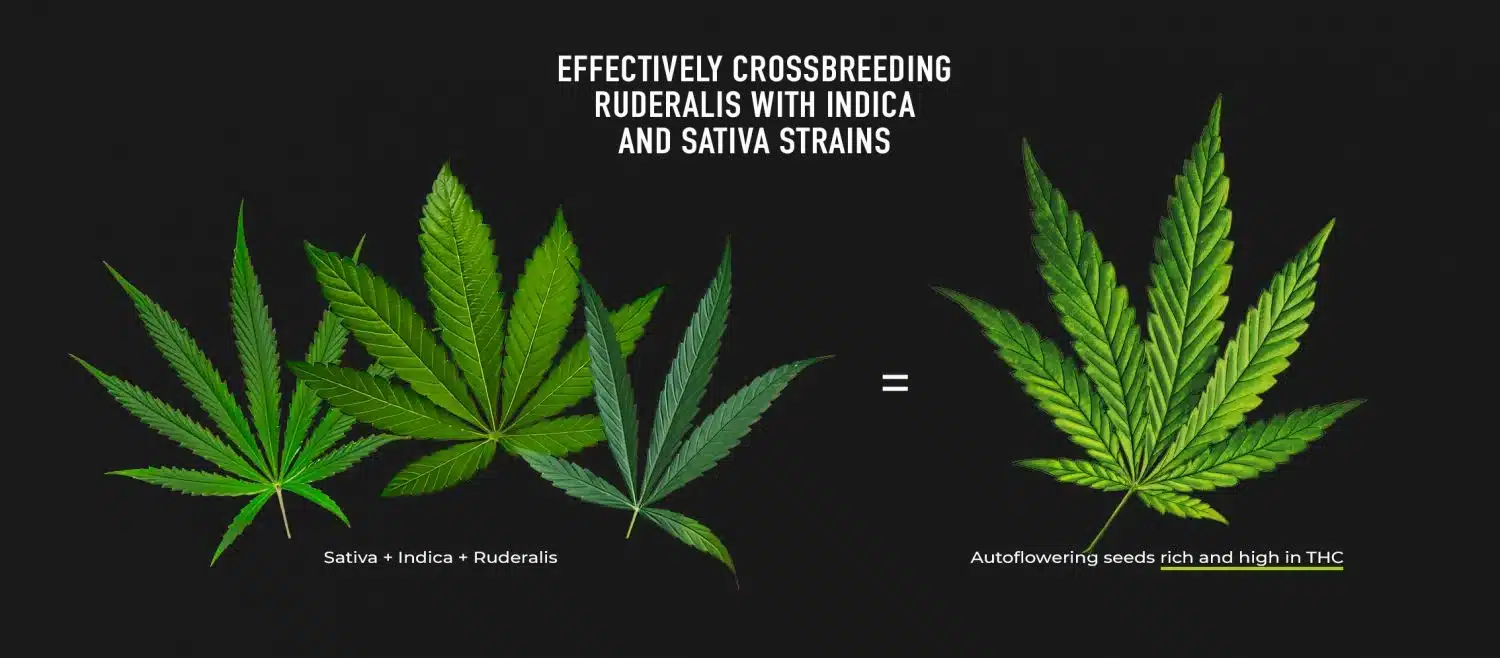
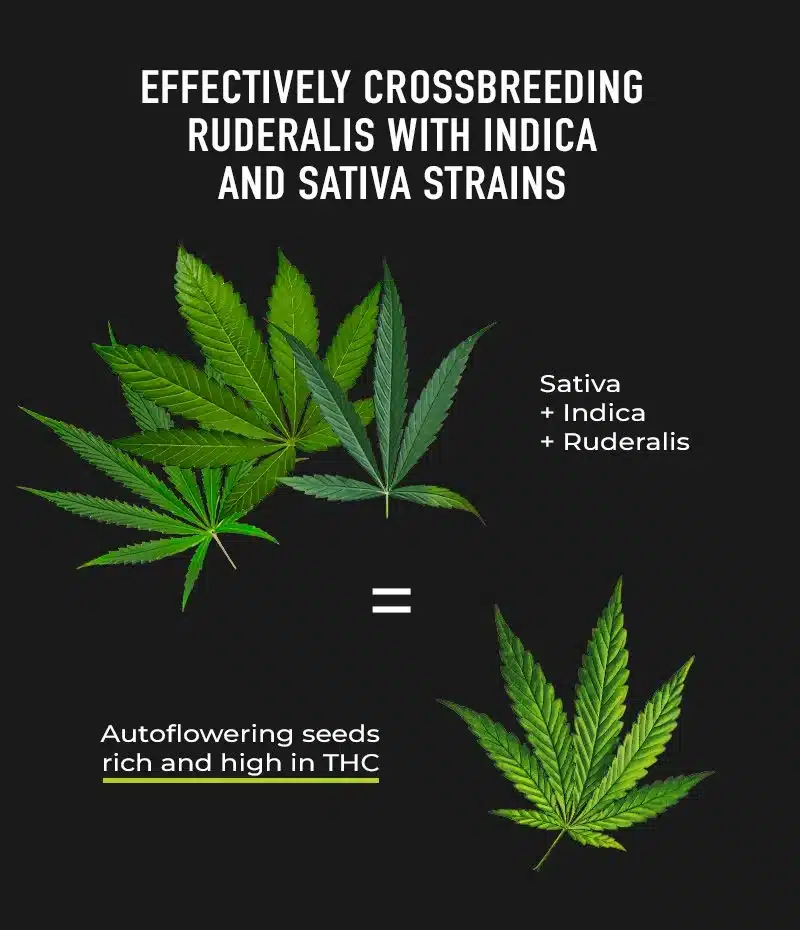
Cannabis ruderalis, which already possesses the necessary autoflowering features, is used to develop the genetic material for autoflowering marijuana seeds. This form of the plant, which is native to regions with cooler climates and shorter summers, such as central and eastern Europe, blooms according to the passage of time rather than the amount of sunshine it receives. In spite of the fact that it is an autoflowering strain, Cannabis ruderalis plants are rather little and naturally contain very little THC. Marijuana seeds that automatically flower have been developed by the skilled breeders at Fast Buds. These seeds are the result of careful cross-pollination with Indica and Sativa strains, which results in buds that are densely covered in resin, have a high THC content, and are ready for harvest in as little as 9 weeks.
Is it true that Autoflowering Cannabis Seeds are hermaphrodite?
No, all of our genetics have been carefully chosen in order to cultivate particular characteristics, such as the production of flowers, the aroma, the effect, and the structure. In addition to the characteristics that have been discussed, all of our genetics are feminized. This indicates that our strains have been selected and bred such that they do not exhibit hermaphroditic qualities, which has led to virtually entirely female plants. For those of you who aren't familiar with the term "hermaphrodite," "hermies" are essentially mixed-sex plants, which means that hermies are plants that grow both male and female sex organs; when the pollen sacs open, they end up pollinating the buds, which will end up producing seedy buds. Hermies are plants that grow both male and female sex organs. Now, according to the makeup of cannabis, marijuana seeds have the potential to develop into hermaphrodites if they are subjected to stressful conditions such as high heat or cold, bugs, mildew, overwatering and overfeeding, or any combination of these factors. Keep in mind that this does not have anything to do with the genetics per se because it is a mechanism cannabis has to propagate their species if they feel like they are about to die. Because of this, if you're experiencing troubles with hermaphrodites, be sure to examine your growing circumstances!
Will My Seeds for Auto Weed Grow Into Plants?
We at Fast Buds, the industry's premier autoflowering cannabis seed bank, constantly make sure that each and every one of our marijuana seeds is put through rigorous testing before being released onto the market. This is why we are able to guarantee a germination rate of 98 percent. It is essential to keep in mind that marijuana seeds are living organisms, and that the environment in which they are stored might have an effect on whether or not they will develop into viable plants. In the event that a seed does not germinate, you may get in touch with us by filling out our warranty form, and we will immediately ship you a replacement that is completely free of charge!
What is the best way to preserve my seeds?
When you've finished purchasing cannabis seeds, the next step is to carefully preserve them. Your automated marijuana seeds have the potential to remain viable for up to ten years if they are stored in ideal conditions; it is important to remember that marijuana seeds are living. The ideal storage temperature for marijuana seeds is between 8 and 12 degrees Celsius (45 and 55 degrees Fahrenheit). If you do not have access to a refrigerator, you should store the seeds in a dark, dry place that is as near as possible to these temperatures.

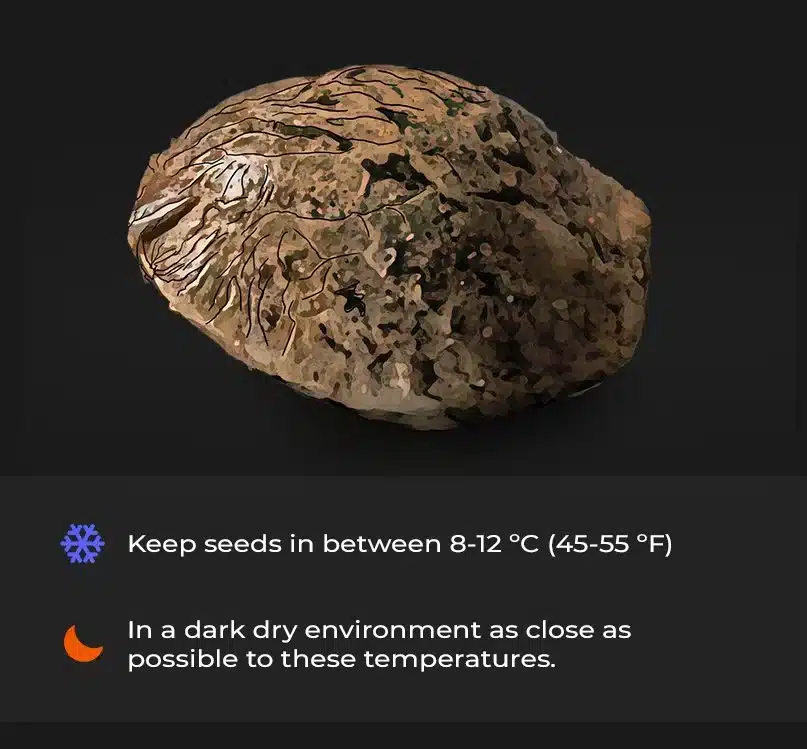
How can I get my autoflowering seeds to start the germination process?
The initial phase in the growth cycle is the germination process, which must be successful. Once you have made the purchase of your autoflowering seeds, it is essential to ensure that you proceed with the proper procedure. Temperatures between 21 and 26 degrees Celsius and humidity levels that are as near to 90 percent as they can go are the ideal circumstances for the germination of autoflowers. You can choose to initiate the germination process using a variety of techniques, the most frequent of which are as follows, depending on your age and the degree of expertise you have with growing:
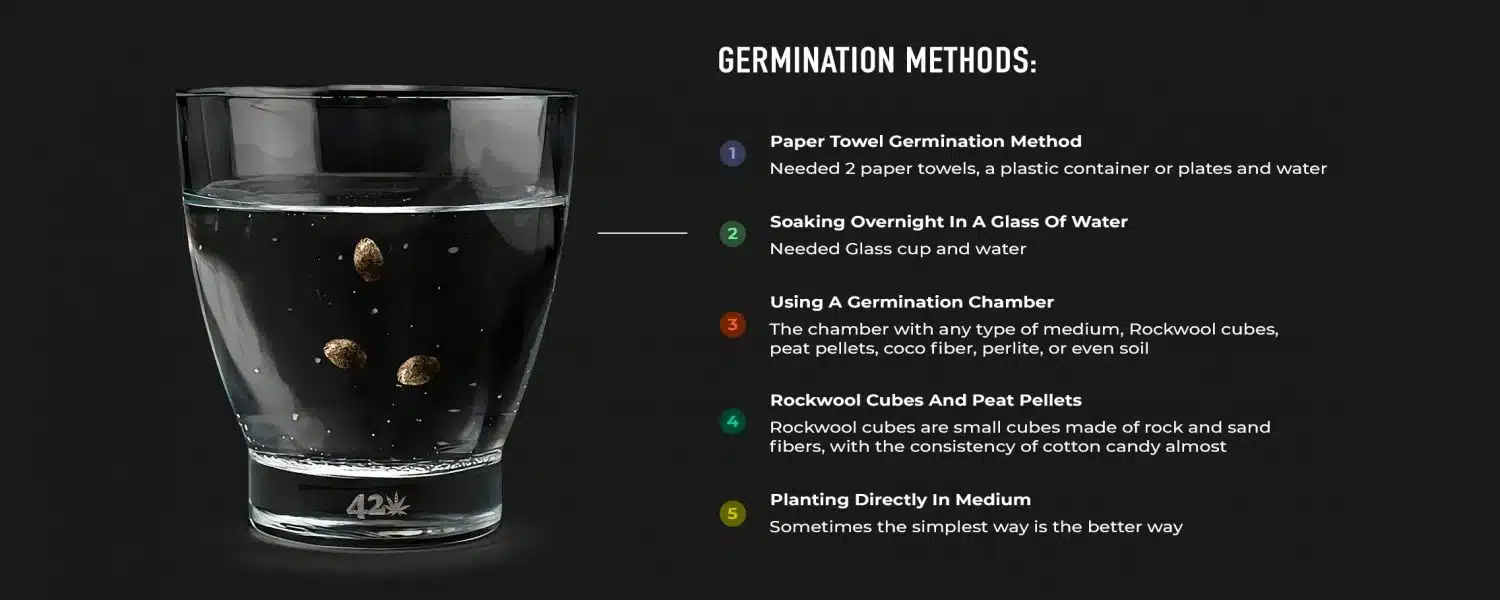
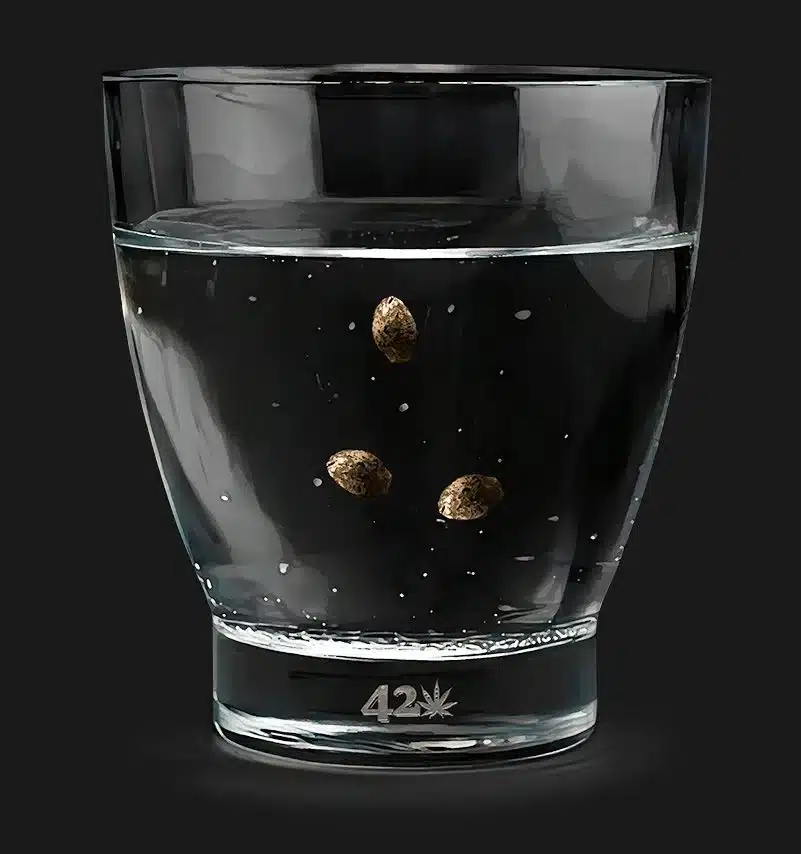 Seedling plugs, Jiffy pods, and starting cubes are all examples of
this.
Seedling plugs, Jiffy pods, and starting cubes are all examples of
this.
Germination is made very simple when using Jiffy pods or other similar products; all that is required is to drop the seed in the pre-formed hole, clamp the top to seal it, and water according to the instructions. There is virtually no room for error since it is so difficult to do it wrong and as long as the conditions are favorable for germination, there is nearly no room for error. Putting the seeds right into the medium. You may plant your weed seeds directly in the final pot, just like in nature where weed seeds germinate directly in the soil; Just as in nature where weed seeds germinate directly in the soil, you can do the same thing. Because the plant is already in its permanent container, you do not run the danger of surprising or stressing the seedlings in the same way that you would if you were to transplant them. This is one of the most significant advantages. However, the approach with paper towels is by far the most widespread. This is accomplished by placing damp paper towels both underneath and on top of the feminized seeds, and then hermetically sealing in the moisture by placing plates both above and below the container. The typical approach of using paper towels may not be the best option for you depending on your budget and the circumstances of your garden. There are other alternatives that you may try instead. Check out our comprehensive guide on the germination process for autoflowering seeds to get a complete rundown of the germination choices that are at your disposal.
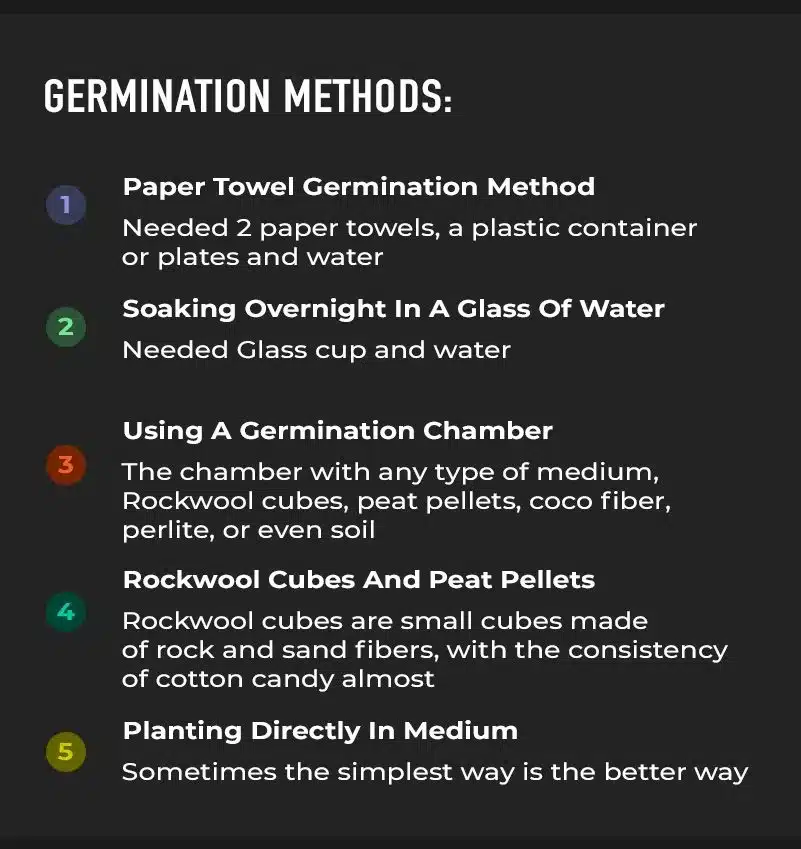
How long till the flowers appear on my autoflowering plant?
When compared to ordinary strains, autoflowers mature and blossom more quickly, which results in a shorter total growth period. However, the exact amount of time saved by producing autoflowers is contingent on the particular genetics that are being utilized. Indica-dominant strains typically finish in a shorter amount of time due to their more compact and shorter growth, whereas Sativa-dominant strains typically finish in a longer amount of time due to their taller growth. This typically adds anywhere from one to three weeks to the total grow cycle, which is completely normal. This implies that autoflowering genetics might take as little as 7 weeks or as much as 11 weeks, depending on the strain; however, on average, autoflowering genetics require 9 weeks, which can be divided into the following stages: vegetative growth, flowering, and fruiting.
- Seedling to Vegetative stage - Day 1 - 28
- Pre-flowering stage, which occurs between days 28 and 35
- The flowering stage lasts from day 35 until day 63.
Please keep in mind that these timings are based on strains that require 9 weeks from the moment the seed is planted until it is harvested when circumstances are optimum. If you have any issues that slow down development, such as cold weather, overfeeding, or any deficiencies, the growth cycle may be disrupted, and as a result, the total number of weeks may wind up being increased by a few of weeks. Keep in mind that the fertilizers, lighting, substrate, and size of the pot all have an effect on the growth of your plant. Because of this, it is essential that you take all of these factors into consideration and give the finest growing conditions that you can.
Comparison of Cannabis Autoflowers vs Regular Plants
When you acquire cannabis seeds, the primary differences between them are their genetics and the manner in which they begin blooming; You may already be aware of this, but when your plants are in the vegetative stage, they are devoting their energy to the processes of nutrient absorption, root development, and the formation of leaf. After reaching this point, the plants will begin to produce blooms, the number and type of which are determined by the amount of darkness and light they get (aka light cycle). It is because of this that they are referred to as photoperiodic, but autoflowers are a little bit different. Autoflowering genetics do not require a different light cycle to trigger flowering because they are genetically selected to flower based on their age. This is a huge advantage if you are looking for a plant that delivers in both yields and quality while also being easy to take care of and growing significantly more quickly.
When it comes to growing autoflower seeds, what are the most important tips for first-time growers to keep in mind? If this is your first time cultivating plants, the sheer number of options available to you for your grow cycle may seem intimidating. Inadequate planning and consideration will result in a low yield, and in the worst case scenario, it will cause the plant to fail to mature at all.
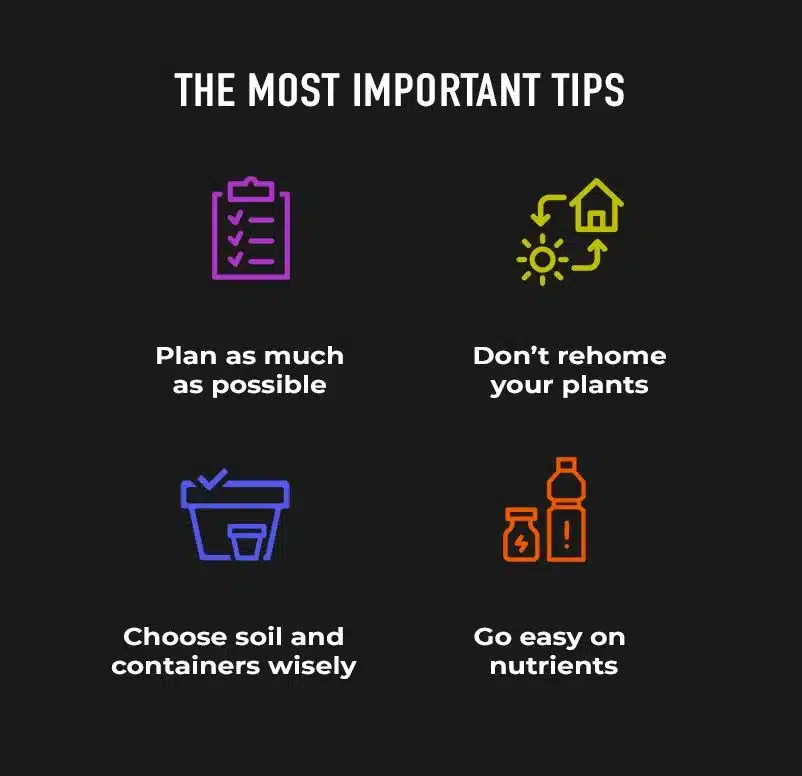 When it comes to cultivating autoflower seeds, there is a great deal to
understand; nonetheless, here are some of our best recommendations to get you
started:
When it comes to cultivating autoflower seeds, there is a great deal to
understand; nonetheless, here are some of our best recommendations to get you
started:
- Make as detailed of a plan as you can: even before you buy anything, you should think about the entire growing process. Which type of soil do you plan to use? Where do you plan to develop? Once germinated, autoflowering weed seeds develop quickly, and as a result, you need to have a comprehensive strategy in place before beginning the process of cultivating the plant.
- It is normal practice in other types of growing conditions to transfer plants to a new pot that is larger whenever they reach a particular size. However, you should not do this with your plants. This is not a risk you can take with autoflowers because of their quick development cycle, which leaves little time for recovery. Because of this, you should put your autoweed seeds in a container that is large enough to hold the fully formed plant.
- Make a careful selection of the soil and the containers. A well-aerated soil that has the right amount of both air and water is ideal for growing autoflowers. You could even want to explore utilizing cloth pots because they provide excellent drainage and maintain the soil in pristine shape.
- Take it easy on the nutrients. One of the most typical blunders that beginning growers do is to use an excessive amount of fertilizers. When it comes to additives, more is not better in this instance, and it is essential to begin with the smallest possible amounts in order to prevent nutritional burn. You should begin by applying the solution at a strength that is half or perhaps a quarter of what is advised for your plant and then observe how it reacts.
Can I perform plant training techniques on my autos?
However, if you have sufficient experience, you can definitely perform any of the plant training techniques mentioned below; just make sure you do it carefully to avoid stressing your plants. Most growers perform basic training to get the most out of each seed without stressing them because this may end up stunting growth and result in an underwhelming harvest. There are two distinct approaches to the cultivation of plants:
Low-stress trainingLow-stress training, also known as LST, is the process of changing a plant's shape and height by gently bending the stems, either by tying them down or bending them under a scrog net. This allows growers to even out the canopy and helps the light reach all of the flowering sites equally, all without putting too much stress on your plants, hence the name low-stress training.
High-stress trainingHigh-stress training, also known as HST, fundamentally produces the same benefits as low-stress training, but in contrast to LST, it is accomplished by mutilating your plant, which may end up causing your plant to be subjected to a great deal of stress. This strategy also leads in improved bud growth; but, if you don't have expertise with training techniques and producing autoflowers, it may not be the ideal technique to use for developing autoflowers. Now that you have a basic understanding of plant training, I will walk you through the primary training techniques that are recommended for autoflowers. Keep in mind, however, that if you are just starting out, you should avoid performing HST until you have a significant amount of experience in order to avoid ruining your harvest.
What exactly is the difference between the LST and the HST?Both of these methods of plant training allow you to shape your plant in whatever way you choose; however, the way in which they accomplish this goal is different depending on which method you choose. High stress training simply involves mutilating your plant, and low stress training involves gently bending the branches, therefore the main difference between the two is how it's done. Other than that, there aren't really many distinctions between the two.
Tying Down Branches
This technique is especially helpful if you have a limited grow space or want to fit as many plants as possible in your grow tent because it allows you to control both vertical and horizontal plant growth. The tie-down method can be used to maximize yields by spacing out the branches to provide better air flow and increase light penetration with minimal stress.
Pros of Tying Down Branches- Increased productivity while using the same infrastructure.
- The ability to modify the size and shape of your plants is provided.
- Will not subject your plants to an excessive amount of stress, which will allow them to recuperate more quickly.
- It is necessary to do maintenance each day to fix the ties and to secure the branches.
- Depending on how many plants you intend to cultivate, this process might take a significant amount of time.
- To prevent the branches from breaking, you will need to do it carefully.
The tying down of the branches is a very simple process. When your plant has completely formed three sets of leaves, all you need to do to prepare it for harvest is to tie down the main cola and any branches that have developed. Therefore, to begin, you should gently bend the main cola down, then you should fasten it in position with the material of your choosing, and last you should tie it to the sides of the pot. After a number of days, you will observe that your plant continues to grow upwards; thus, you will need to locate the upper branches and tie them down as well. Your plant will create a more equal canopy after the initial tie downs, but the training is not finished there. Continue tying the branches and adjusting the ties so that they are always holding the branches from the tip in order to keep the desired shape. Since the main cola and the branches will continue to grow upwards until the pre-flowering technique, this is necessary in order to keep the plant in the desired shape. Continue doing so until you have achieved the form you want. When you have accomplished your goal and your plant has grown to an appropriate size, you may then go to the 12/12 position. Because your plant will not grow very much once it has flowered, you can remove the ties from it and then let it to blossom naturally.
Scrogging
Growing a plant under a scrog net is an additional approach for managing plant development while avoiding stress; in order for this method to function, a net must be placed over the canopy of the plant, and the branches and main stem must be bent. If you have a big number of plants and don't want to tie down each individual branch, this method is highly suggested because it not only controls height but also provides support if it's required.
The benefits of scrogging- Less upkeep owing to fewer plants.
- Because you will require fewer seeds and clones, you will have a lower overall cost.
- Maximize the potential of each individual plant.
- Because of the scrog net, it is difficult to relocate the plants.
- Having difficulties with only one plant might have a big impact on the whole crop.
- To guarantee that the plants are correctly trained, it is best to use those that vegetate for longer periods of time.
If you are interested in trying your hand at scrogging, all you really need is some patience and a scrog net. Be careful to measure everything first, trim the net down to the size you want, and then secure it to the framework of the grow tent. Check that it doesn't fit too snugly so that you have room to modify the height if necessary. When utilizing this method, it is suggested to cultivate a smaller number of plants within bigger containers. In most circumstances, four plants grown in pots of 20 liters are the optimal number to use for one square meter. It should take between six and eight weeks for the entire scrog net to be filled. You might need to cultivate more plants if you're cultivating autoflowering strains due to the fact that autoflowers often have a shorter growth cycle, but it is possible to scrog autoflowers and still have excellent yields. Because every plant develops in its own unique way, you'll need to remember to modify the scrog net as needed. Sometimes you'll need to lower it, and other times you'll need to raise it. When your plants have reached the point where they are producing flowers, the canopy should be uniform and have many flowering sites throughout.
Supercropping
This technique can definitely be used with autoflowering strains, but you need to ensure that the growing conditions are optimal so that you do not stunt the plants' growth and they can recover as quickly as possible. Supercropping, also known as pinching and bending, is a high-stress technique that has the potential to produce good results if it is carried out correctly.
The advantages of supercropping- Swift and not very difficult.
- There is no requirement for any other tools.
- Greater productivity with no necessary changes to the machinery.
- Errors can sometimes end in tragedy.
- It takes longer for plants to recover from the effects of stress.
- There is the possibility of adverse effects on plants.
Supercropping is probably one of the quickest plant training techniques because it can be done in just two easy steps and you don't need any tools to do it. However, before you begin, you absolutely need to be familiar with how cannabis plants grow and have an idea of what you want to accomplish with your crop. Once your plant has produced around six nodes, you should begin by considering where it would be most beneficial to supercrop in order for the canopy to develop evenly. Once you have determined the appropriate location, you should then supercrop all of the essential branches. When you take a branch, hold it between your fingers and slowly squeeze it; the branch should feel soft and limp; after the branch feels soft, gently bend it at an angle of ninety degrees. The upper portion of the branches are more flexible and simpler to bend than the lower portion. This is the end! It is obvious that you will need to continue to do it to the rest of the branches if you believe that it is essential; nonetheless, the technique remains the same; all that has to be done is to repeat it until the canopy is smooth and even.
Topping
Topping is another high-stress technique that results in growth that is comparable to what you would get with scrogging. However, topping is typically not very good for autoflowering plants if the grower does not have a lot of experience with the technique because it involves mutilating the top growth, which can be quite stressful, so extreme caution is required.
Pros of Topping- Instead of simply one, there are many primary colas.
- Can be utilized in conjunction with a variety of different types of training.
- You can get the most use out of your light fixture if you level out the canopy.
- Topping results in an open wound, which significantly increases the risk of an infection caused by a disease.
- Can be a really distressing experience for certain strains.
- If circumstances are not optimal, it may take plants a long time to go back to normal.
Topping is often done after your plant has produced between 3 and 5 nodes. However, it is important to note that the majority of growers wait until the plant has developed at least 5 nodes before topping it. Additionally, it is advised that you only do it if your plant is tall enough and healthy enough; this suggests that topping might not be the best option for all strains. The next step is to get some sharp scissors, wipe them off with some rubbing alcohol, and then cut off the very tip of the top growth. To prevent your plant from experiencing any more stress, make sure that when you clip the top growth you do not remove any of the neighboring leaves or branches. It may appear as though your plant is growing more slowly after you have topped it, but don't worry about this; this is because your plant needs time to recover. However, once it has recovered, you will notice that there are two branches growing upwards; this is how you will know that you have topped your plant correctly. If you want to encourage even more branching, you can keep topping the new growth until you have achieved your desired level of branching. Keep in mind that topping will cause vegetative development to slow down, and as a result, the vegetative stage will last longer the more topping you conduct.

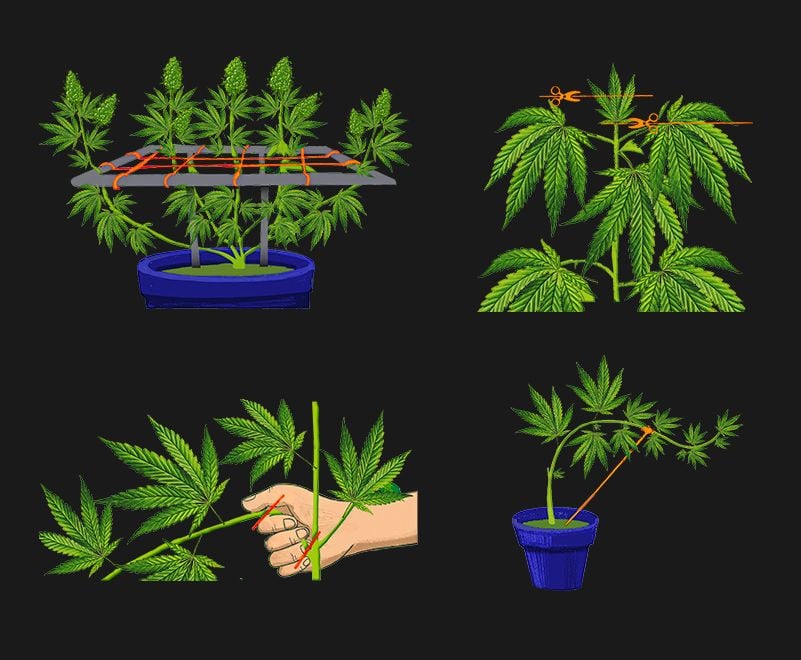
Are Autoflowering Cannabis Seeds Suitable For Growing Outside?
In a few words, yeah. It is possible to cultivate autoflowering marijuana throughout the entire year because it is not dependent on the light cycle to trigger the flowering process. However, for the best results possible, it is recommended that you plan ahead to ensure that your plants receive the maximum amount of sunlight and that they do not suffer when it snows. When you purchase autoflowering cannabis seeds from Fast Buds, you are getting a product that can be cultivated successfully either inside or outdoors, depending on the environment. Your feminized seeds will produce healthy plants if you take the necessary precautions to shield them from predators and the weather, such as keeping them dry and avoiding temperatures that are too low. However, it is essential to keep in mind that the total yield will be dependent on the quantity of light exposure; hence, there are periods of the year when it can be more beneficial to cultivate the plant indoors rather than outside. It is advised that those who are new to growing cannabis outdoors choose Indica-dominant strains, since these plants have historically been able to better adapt to harsher and more adverse environments. Get in touch with us if you have any inquiries on the best beginning strains for autoflowering seeds and we will be happy to assist you further. After you have acquired your autoflower seeds, it is a good idea to check our guide on Growing Autoflower Seeds Outdoors, in which we have included a comprehensive discussion of the cultivation procedure.
Are Flowering Autoflowering Seeds Suitable For Indoor Cultivation?
The cultivation of autoflowers insideBecause autoflowering marijuana plants are not dependent on a certain light cycle, it is possible to offer anywhere from 18 to 24 hours of light each day while growing the plant inside. This gives the grower greater flexibility over the environment. If money is not an issue for you, you may retain a 20/4 or 24/0 light cycle from seed to harvest, which will result in quicker plant development and greater yields. A 18/6 light cycle will give the energy your plants require while still saving a bit of money on the electricity bill.
The optimal environment for your autoflowering plantsIt is advised that particular temperatures and relative humidity levels be maintained in order to produce the optimum results. As a consequence, it is recommended that the following growth conditions be maintained within the acceptable range:
- Seedling stage: 20-25 degrees Celsius with 50-60 percent humidity
- Vegetative stage: 22-28°C / 40-70 percent humidity
- Early Flowering stage: 20–26 degrees Celsius and 40–50 percent humidity
- Late Flowering stage: 18-24 degrees Celsius with 30-40 percent humidity
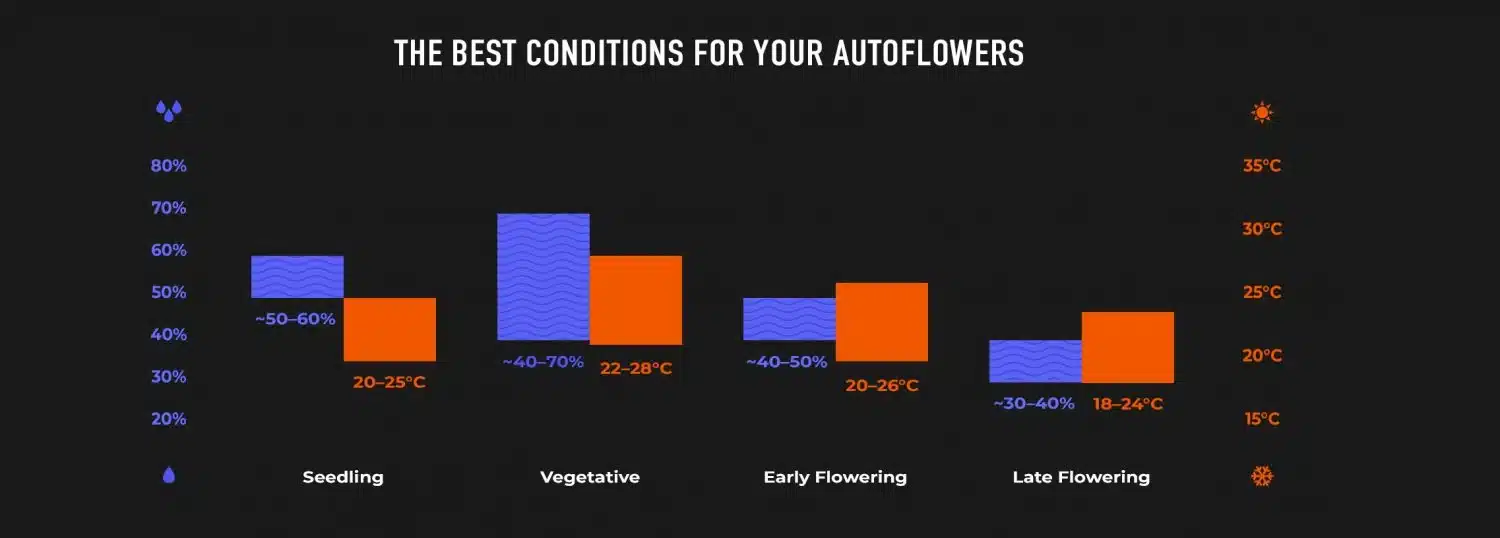
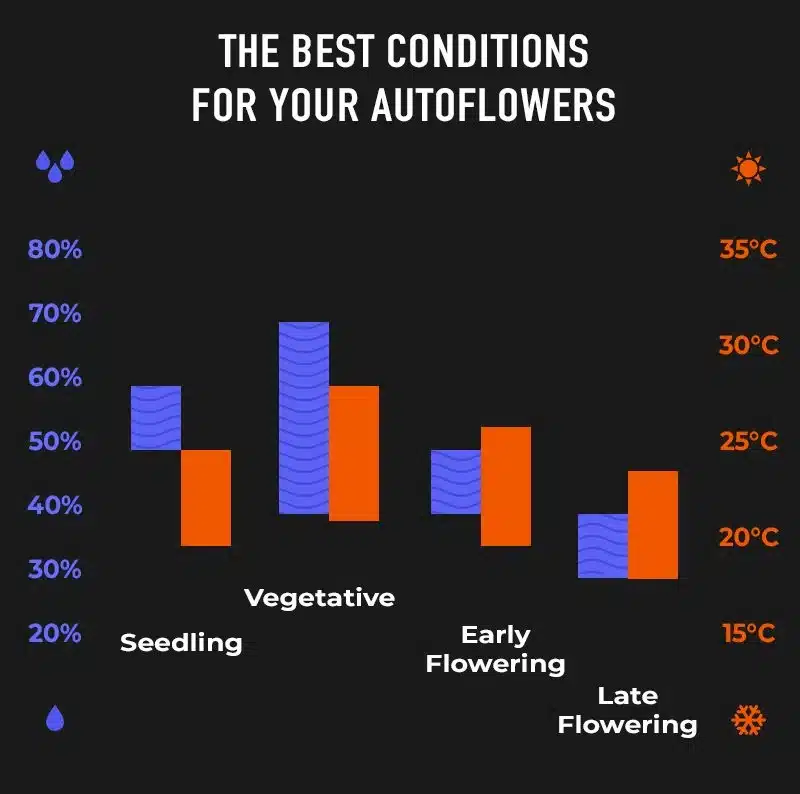
growing outdoors, there is not much you can do other than plan ahead and begin your grow cycle when the conditions are as close as possible to the conditions mentioned above. Obviously, it will be much easier to maintain these conditions when growing indoors due to the specific equipment that is needed to do so.
What should one keep in mind?
Autoflowering plants mature according to the genetic timetable they were given at birth, which means that not all strains will mature and flower at precisely the same moment. If you are growing feminized seeds from the same strain, then it is highly likely that they will start flowering at the same time. However, if you are growing different genetics in the same space, then it is likely that they will start flowering 1-3 weeks earlier or later. Therefore, it is important to make sure that you plan ahead and keep this in mind, particularly when growing indoors. Always keep in mind that breeders have top-of-the-line equipment, and the time from seed to harvest that is specified is based on those conditions. If you have trouble maintaining good growing conditions for your plant, it may take a little bit longer to be ready for harvest; however, this will in no way affect the bud's quality or quantity, so you shouldn't worry about it.
What is the Ideal Light Cycle for Autoflowering Plants?
Growers like making use of autoflowering cannabis seeds owing to the ease and speed with which they may harvest their plants. Those that cultivate standard strains are likely aware of the uncertainty that exists about the optimal light cycle during the growth process. Because standard strains lack autoflowering features, this uncertainty must be maintained for a greater amount of time. In a recent article, we went through in great detail the issue of the light cycles that are ideal for autoflowering seeds. To summarize our suggestions from the previous section, the article suggests that the ideal ratio of light to dark for growing the majority of autoflowering strains is 18:6. This allows the plant to have sufficient time to rest in between phases of development, regardless of whether it is exposed to natural or artificial light. The resilience of autoflowering strains is widely known, and as a result, even if you switch up the lighting schedule for your cannabis plants, they will continue to develop well even if they are less likely to produce a big yield in most circumstances. Other regularly used techniques, such as 20/4, provide a shorter rest time, while other people swear by the benefits of growing in constant light for the whole cycle. The second method is one that we are hesitant to suggest to most growers since it enables the plant to have a break from the light cycle, which gives it the opportunity to rest and recuperate. Imagine being forced to work out nonstop for a whole twenty-four hours. To achieve their full potential, every plant life, including autoflower seeds, requires regular periods of rest, much like people.
| Light Cycle | Result |
|---|---|
| 18/6 | Normal growth rate and expected yields |
| 20/4 | Faster growth and bigger yields than average |
| 24/0 | Faster overall development but can stress some strains |
Which Light Am I Supposed to Use?
It is possible to cultivate autoflowers under any light fixture you prefer or have available; however, for the best results, it is recommended to provide a minimum of 75 watts of light if using light bulbs or the equivalent for LEDs, which is around 50 watts. Autoflowers do not require any special light fixtures.
Metal HalideYou will still have a nice harvest even if you use an MH bulb for the entirety of the grow cycle; however, it is advised that you switch to an HPS bulb in order to optimize the amount of bud formation. MH lights are fairly good during the first couple of weeks of the grow cycle. If you are forced to select between an MH and an HPS bulb for the duration of the cycle, our advice is to go with the HPS bulbs.
Ceramic Metal HalideCMH bulbs are a sort of improved version of MH bulbs. They consume less power but still provide the same or even better plant growth and trichome production than regular MH bulbs. However, because they emit less heat, it may be more difficult for people who live in colder climates to keep their temperatures at a comfortable level.
High Pressure Sodium, as well as Double Ended-High Pressure SodiumThese bulbs will produce very healthy plants, dense buds, and impressive yields, and if you use a ballast, you will be able to control the light intensity, which is always a plus. It is highly recommended that you use HPS bulbs during flower due to the light spectrum and power. These bulbs will produce very healthy plants, dense buds, and impressive yields.
LEDsDespite their high cost, these lighting fixtures produce really impressive results while using relatively low power. This makes it worthwhile to invest in LEDs if you intend to use them for at least two to three years. In today's world, many growers are switching to LEDs because of the full-spectrum light they provide and their effectiveness. Also, the light spectrum plays a significant role in the cultivation process. Because of this, it is strongly suggested that you provide a "blue" spectrum during the vegetative stage, such as MH or CMH, and a "red" spectrum during the flowering stage, such as HPS or DE-HPS; when cultivating plants with LEDs, a fixture that emits the full spectrum of light will do the trick. When selecting your lighting fixture, in addition to the spectrum, there are a few other factors, such as efficiency and PPFD, that should be taken into consideration.
Effectiveness of LightIt is essential that you are aware of the light efficiency of a specific light since this is what will allow you to save money in the long run. Light efficiency is measured in terms of the watts that a certain light needs to create a particular quantity of PPFD. The makers need to utilize a good LED driver and more individual LED diodes that run at a lower current and release less heat, which will result in a longer lifespan and a greater efficiency overall. This will allow the LEDs to last longer.
Photosynthetic Photon Flux Density (PPFD)Because the term "light efficiency" refers to how much power a certain light source requires in order to emit a particular quantity of photons, there is a direct connection between light efficiency and PPFD. You don't really need to know how much light that fixture produces, but you do need to know how much light reaches your plants. Now, keep in mind that PPFD is not the same as PPF. PPF refers to the amount of light that is produced by a light fixture, while PPFD refers to how much light reaches your plants. Now, keep in mind that PPFD is not the same as PPF. If you divide the PPF by the actual power usage (wattage), you may figure out how efficient your light fixture is. The higher the number, the more efficient your light fixture is.
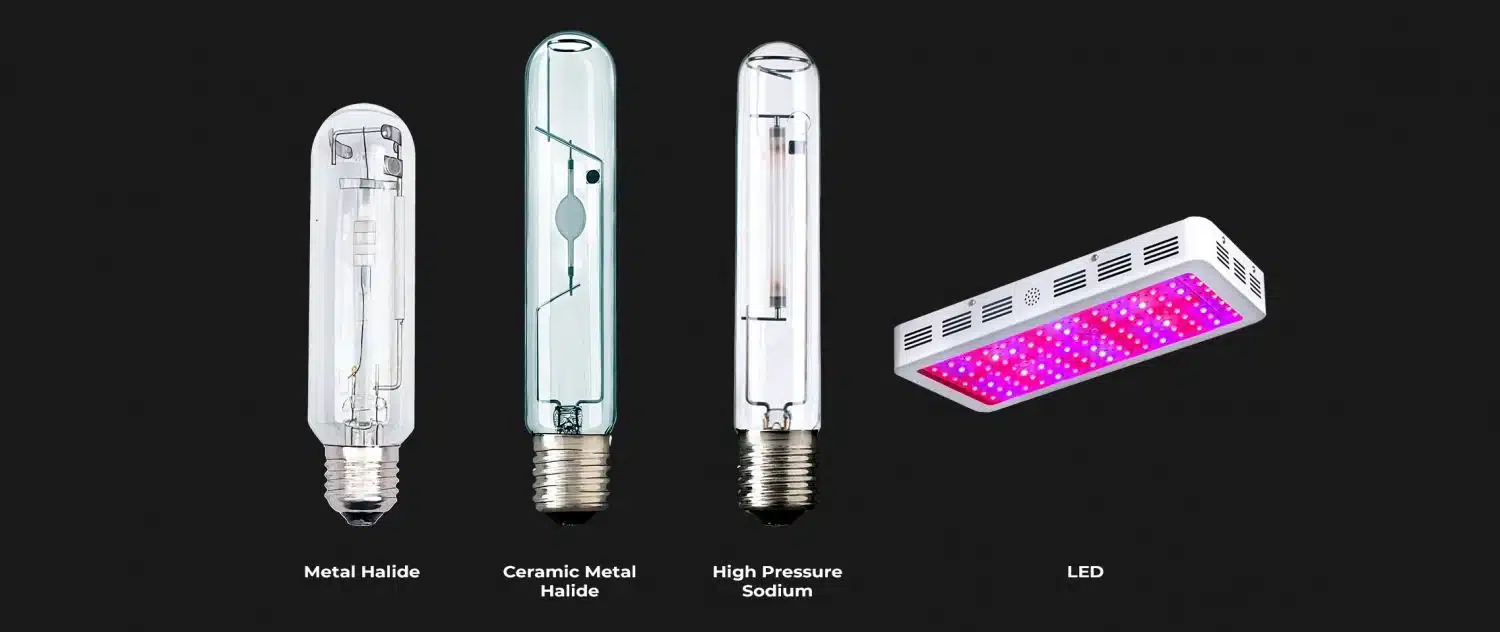
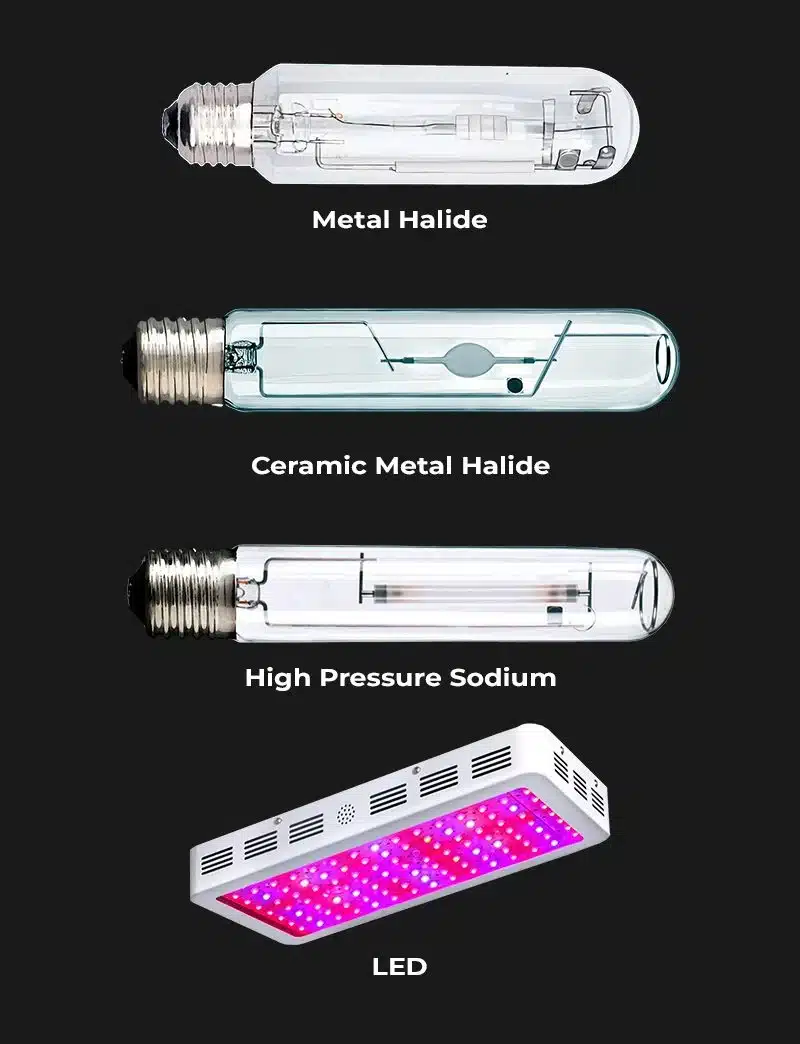
Which Strains of Autoflowering Seeds Are Ideal for Growing Marijuana Outdoors?
There are a number of strains that, in comparison to typical strains, are better able to endure severe settings since they have autoflowering features buried within their genetic makeup. Having said that, if you intend to cultivate cannabis outside in damp or chilly climates, finding a strain that is resistant to these circumstances is absolutely necessary. If all of the above describes your situation, then we would suggest the following strains to you:
Check read our earlier post on the best autoflowering strains for outdoor cultivation to see a list of suggestions that is even more comprehensive than the one provided then.
Which autoflowering genetics provide the highest yields, and how can I find them?
Growing is a science, and as such, yields can vary significantly depending on the conditions and quality of the grow cycle. Depending on the conditions and quality of the grow cycle. Having said that, our crew is very skilled in the art of perfecting growth, and as such, we are able to tell you that under the ideal growing circumstances, the following autoflowers will produce the maximum yields:
- Gorilla Glue Auto - Up to 450-600gr/m2
- Wedding Cheese Cake - Up to 450-600gr/m2
- Orange Sherbet Auto - Up to 650gr/m2
- Northern Lights Auto - Up to 500-600gr/m2
- Zkittlez Auto - Up to 450-600gr/m2
Check read our post on the top 5 autoflowering cannabis strains with the best yields for additional information on the strains mentioned above and the usual characteristics they exhibit once they have been harvested.
Which Autoflowering Cannabis Strains Yield The Highest Amount of THC?
There is no question that the quantity of THC present in the buds is the single most essential component in determining both the quality and the intensity of the high that they provide. This is true regardless of how the buds are consumed once they have been harvested. If you are an experienced smoker or are planning to produce cannabis for others who are more accustomed to the effects of frequent usage, then you should aim for a high percentage of THC. We have been successful in developing strains that rank among the highest producers of THC that are now on the market thanks to the application of genetic engineering and the most advanced breeding techniques. In general, the following are the strains that we believe to be our strongest:
- Gorilla Cookies Auto - Up to 27 percent
- Strawberry Pie Auto - Up to 26%
- Gelato Auto - Up to 26 percent
- Orange Sherbet Auto - Up to 24%
- Gorilla Glue Auto - Up to 24 percent
Check out our post on the top 5 autoflowering strains with the greatest THC content for additional information on the strains mentioned above and the usual characteristics they exhibit once they have been harvested.
Are There Medical Strains That Have the Capability to Flower on Their Own?
Yes, if you are interested in taking advantage of the therapeutic advantages of CBD, we also offer strains that have been genetically developed for the specific aim of achieving these outcomes. Our CBD Auto 20:1 is a great option for people who are simply interested in CBD and want to avoid the psychoactive effects of THC. As the THC levels in this strain are as low as 0.3 percent, smoking it is legal in many countries, and as the CBD levels are as high as 20 percent, consuming it can assist with ailments such as chronic pain. Our recommendation is CBD Auto 1:1 if you are searching for a strain that strikes a good balance between the effects of THC and CBD, or if you are just starting out with the intake of cannabis and are curious about its benefits. Both the therapeutic value of smoking and the pleasure that may be derived from doing so are optimally balanced at 7 percent THC and 7 percent CBD.
How can one make the most of the advantages offered by pharmaceutical treatments?


There are a number of applications for CBD-rich feminized seeds; however, the majority of medical users have health problems and are unable to smoke CBD strains. Fortunately for you, however, you can vaporize it to avoid inhaling potentially harmful smoke, or you can make several CBD-infused products such as edibles, oils, creams, and gels that will surely alleviate pain or other symptoms without actually having the psychoactive effects that the majority of medical users do not want to feel.
For Which Growers Are Autoflowering Seeds Most Appropriate?
The purchase of feminized seeds is quickly becoming the most popular option for gardeners, whether they are cultivating plants for personal or commercial use. Growers in the business sector prefer the use of autoflowers because of the ease and quick turn around that they provide. When combined with recent advances in genetics, this implies that commercial producers must choose cannabis strains with high yields, high THC content, or even compact sizes in order to cultivate the most number of plants possible in a given space. Those who cultivate plants for their own recreational use choose growing plants from feminized seeds for the same reasons. Additionally, because to the carefully chosen genetics, the cultivation procedure is far more accommodating to inexperienced growers. Growers who cultivate cannabis for their own personal use may reap all of the benefits of having their own supply with very little work thanks to quicker turnaround times and strains that are well-suited for outdoor cultivation.
Which Type Of Soil Is Ideal For Cannabis Seeds That Flower On Their Own?
It is a prevalent misperception that the soil's sole purpose is to maintain the plant standing upright, which results in the soil's frequent underutilization by amateur gardeners. Growing a robust plant with dense buds that are coated in resin depends on a number of factors, one of the most significant of which is the soil. If you are seeking for a straightforward method for your first grow, organic soil is the medium that will serve you well. Because the soil is always in a state of decomposition, the nutrients that are in it are always being released to your plant, providing it with enough of food to power its growth. In addition, the soil can be supplemented with other additives, such as coco, biochar, or perlite, each of which has its own particular set of advantages. It is not difficult to evaluate the quality of the soil on its own. A soil of high quality will have a label that provides specific nutritional information, will be rather light in texture, and will be devoid of significant clumping and density. The best soil is often odorless as well; if the dirt you have is smelly, it is probably full of germs that are harmful to plants and shouldn't be utilized. Should you feel the need to refresh your memory before purchasing autoflower seeds, we have already discussed in a great deal more depth which type of soil works best for autoflower seeds. You are not limited to using soil as your preferred medium for growing plants; rather, you can choose from any of the alternatives listed here instead:
- Toadstool moss
- Perlite
- Vermiculite
- Coco fiber
Because each of these substrates possesses a unique set of properties, they need to be combined in a manner that is appropriate for the conditions under which the plant is being grown. For instance, if the humidity is too high, you should add 20-40 percent perlite to your preferred substrate mix. If the humidity is too high, you should add 20-30 percent vermiculite or peat moss.

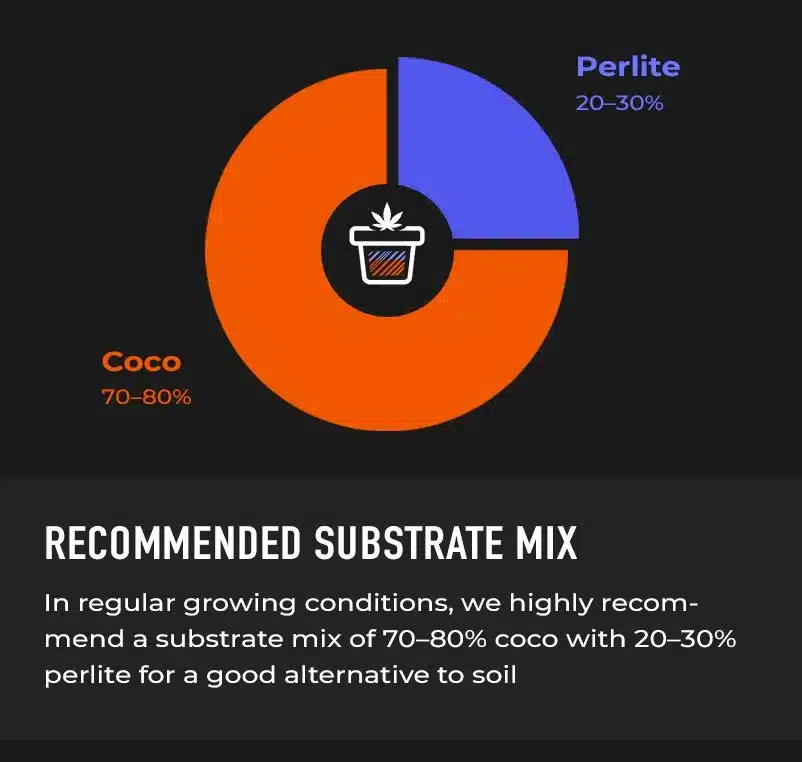
In typical growth circumstances, we strongly advise using a substrate that consists of 70–80 percent coco and 20–30 percent perlite as a decent substitute for soil. These percentages should be mixed together.
What kind of water should I use?
The pH level of the water can have an effect on which nutrients your plant gets; nevertheless, as long as the pH level is within the permitted range, it really doesn't matter where the water originates from. We recommend increasing the pH to 6.0-7.0 when growing in soil and 5.5-6.5 while growing in hydro or coco fiber. The perfect pH will vary according on the substrate you're growing in and the fertilizers you're using, but in general, we recommend adjusting the pH to those ranges.
How frequently do I need to water my autos?
Because the frequency of watering is going to be determined by the particular growth circumstances that you have, there is no way to tell exactly how much water you will need to water with. This occurs as a result of the fact that the levels of humidity, temperature, the strength of the light, the substrate, the size of the pot, and everything else will effect how water evaporates and will govern how much time it takes for the substrate to dry up. As a general rule of thumb, you should water your seedling with 100 milliliters of water, and as your plant grows, you should progressively increase the quantity of water you give it. The most important thing to do is to water your plant once every two to three days whenever the substrate reaches around 70 percent of its dryness.
What is the ideal amount of space for the pot?
It is advised that individuals who have a lot of growing space use 12-liter pots to enable the plant to develop to its greatest potential. However, it is feasible to limit their height based on your setup and the area you have available; if you have a lot of growing room, use 12-liter pots. You have complete control over how large your plant will get if you select an appropriate container for it to mature in; a typical rule of thumb is as follows:
| Pot Size In Liters | Approximate Plant Size in Cm |
|---|---|
| 1 | 15 cm |
| 3 | 25 cm |
| 5 | 60 cm |
| 11 or more | Full plant height |
What Kind of Nutrients Should I Give My Autoflowering Plants?
It doesn't really matter what type of fertilizers you use as long as you
begin with a lower nutrient dose when growing autoflowers because autos
require fewer nutrients than other types of feminized seeds and most
fertilizers are designed for non-autos. You can use both organic and synthetic
nutrients when growing autoflowers. However, autos need fewer nutrients than
other types of feminized seeds. Now, some strains may require more than
others, so it is recommended that you begin with one-third or one-half of the
recommended dose and gradually increase it if you feel like your plant needs
it. If you are unsure whether your plant requires more or not, start with
one-third of the recommended dose. You can use the following basic timetable
as a suggestion to help you organize your time:
Week 1 Seedling - Plain water;
Week 2 Vegetating - ⅛ veg. nutes;
Week 2 Vegetating - ⅛ veg. nutes;
Week 4 Pre-flowering - ½ veg. nutes + ⅛ bloom ;
Week 5 Flowers developing shape - ¼ bloom + ⅛ veg. nutes;
Week 6 Flowering - ½ bloom nutes;
Week 6 Flowering - ½ bloom nutes;
Week 8 Flowering - ½ bloom nutes;
Week 9 Ripening - ½ bloom nutes;
Week 10 Flushing - Plain water.
Can I Grow Autoflowers organically?
Now, the chart that was just presented to you is only a broad guideline, but you can become much more particular if you pay attention to things like the fertilizers that you use. Organic fertilizers, as you may already be aware, make the nutrients in the substrate available for your plant to feed on anytime it deems it necessary to do so. It may appear to be more difficult to develop in an organic manner; however, this is not the case, and there are various methods available for doing so, including the following:
- Composting,
- Korean Natural Farming (KNF),
- Super soil,
- Organic teas are all part of this movement.
However, if you are looking for a method that is both easy and successful, we suggest combining the following ingredients with 1 liter of substrate (either coco or soil; perlite is optional):
| Organic Worm Castings | 500g | Bat Guano | 50g | Azomite | 16g |
|---|---|---|---|---|---|
| Humic Acid | 2.5g | Rock Phosphate | 38g | Epsom Salts | 25g |
| Bone Meal | 50g | Blood Meal | 50g | Dolomite | 16g |
Is Hydroponic Cultivation an Option for Growing Autoflowers?
Yes! It is absolutely possible to grow autoflowers hydroponically and get outstanding results; all that is required is to ensure that the growth conditions are optimal, and most importantly, to monitor the pH, temperature, and part per million (PPM) concentration of the nutrient solution. Even if you are feeding your plant properly, the pH can cause nutrient block, and your plant will not be able to absorb them. Because of this, you should keep the pH in the range of 5.5-5.8. For those of you who are unaware, the pH of the nutrient solution is what will allow your plants to absorb certain nutrients. When you measure the PPM or EC, you will find out exactly how much nutrients your water contains, which is crucial information for hydroponic growing. As a general rule, the temperature of the nutrient solution should be around 20 degrees Celsius, and the PPM values should be the following (approximately):
- Seedlings: 100-400
- Early stage of the vegetative cycle: 400–800
- Late vegetative stage: 800-1200
- Pre-flowering and early flowering: between 1000 and 1400
- Middle of the Flower: 1200–1600
- Flowering late: 1000-500-0
There are many different hydroponic setups, and each one has its own set of benefits and drawbacks. Among the hydroponic configurations that are most commonly used for autoflowering plants are the following:
Deep Water Culture (DWC)Deep water culture, also known as DWC, is a method of growing plants hydroponically in which the plants are grown in special pots or nets (with or without perlite, coco, or clay pebbles) with their roots hanging down. The plants are grown with part of their roots submerged in a nutrient solution and part of them hanging in midair; this allows the plants to consume nutrients while still having plenty of oxygen available to them.
AeroponicsAeroponics is very similar to deep water culture (DWC), but instead of the roots being partially submerged, the entire root system is suspended in midair and is sprayed with water by an automated sprinkler once every three to five minutes. In this way, the roots continue to receive nutrients and oxygen, just as they would in DWC. It is important to keep in mind that while growing plants aeroponically, you should make use of a reservoir that is impervious to light and water in order to prevent the growth of mold and to assist in producing a moist atmosphere in which the roots may flourish.
Irrigation via drip systemUtilizing tiny tubes that are put on top of the soil and equipped with a dripper at the end, drip irrigation supplies a nutrient solution in very small amounts at regular intervals throughout the day. You may also configure it to function every 15 minutes or in any other interval that you like, so ensuring that your plants do not receive an excessive amount of water. This is an excellent method for cultivating autoflowers because it allows you to avoid overfeeding your plants by providing them with modest amounts of nutrients continuously throughout the day rather than providing them with a large quantity of nutrients just once every two to three days.
What are the indications that it's time to harvest my plant?
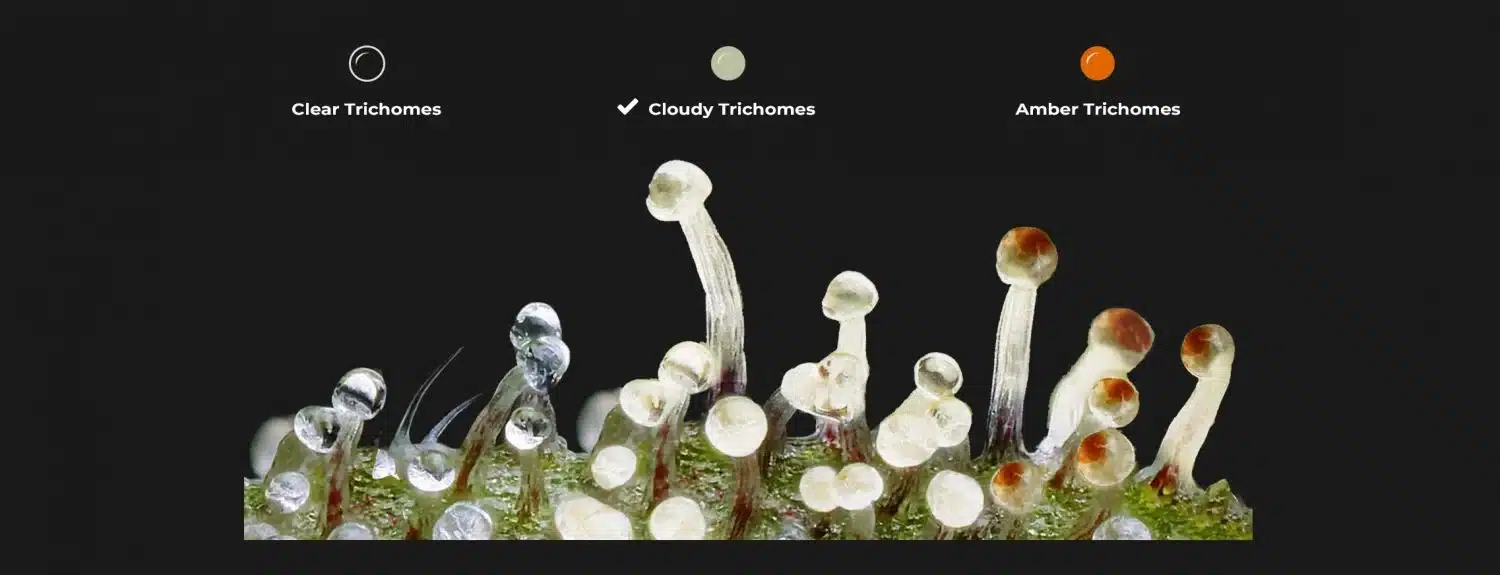
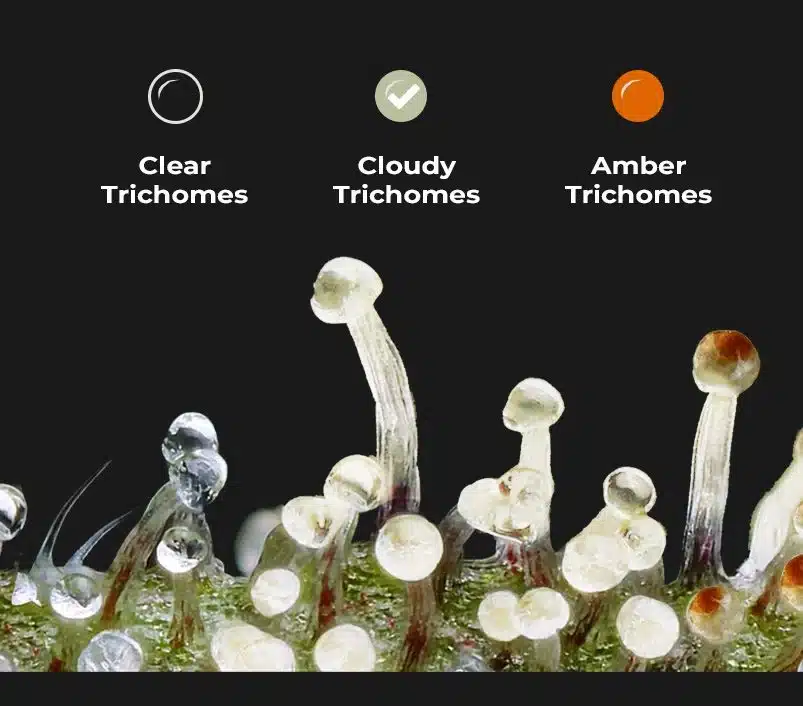
It can be difficult to determine when to harvest your autoflower seeds, and many people who are growing plants for the first time will be eager to select the buds as soon as they appear to have reached their full maturity. After around five weeks of development, you should be entering the phase where bud growth is more prominent. After another seven to eight weeks of growth, the buds will reach their maximum size. On the other hand, this is not the greatest time of year to harvest them! Instead, pay attention to what your plant is trying to tell you. Once you have cleansed your plant in the last weeks before the cycle, you will notice that the plant is taking in less nourishment, and it may start to yellow as a result. As the plant's growing cycle winds down, you'll also note that its odor becomes more potent; this is a sign that the plant's energy is being channeled towards the development of buds. If you observe that the stigmas on your buds are becoming brown and that the trichomes are growing more dense, you will know that they are ready to be harvested. As a result, you should pay close attention to the following, which serves as a guide:
- Swollen calyxes
- Stigmas in brown color (hairs or pistils)
- Water absorption.
When the plant is harvested too soon, the effect is often less strong, and the hybrid strains that are subsequently ingested have a greater sativa dominance. It is important to keep this in mind before harvesting the buds so that you can get the powerful indica effect that results from allowing them to mature for too long. When you have arrived at this stage, it is time to examine the color of the trichomes; Those of you who aren't aware, trichomes are the crystals that appear on cannabis beginning in the pre-flowering stage. These crystals not only produce but also store the cannabinoids, terpenes, flavonoids, and other compounds that are responsible for the effect. Because of this, the color of the trichomes indicates the type of effect that you will experience, and there are basically three different colors: amber, brown, and white.
- It is evident that the trichomes have not yet reached their full maturity;
- Trichomes are functioning at their maximum potential when the substance is cloudy or milky.
- Amber: Trichomes have begun transforming into CBN, which has led to a more corporeal impact.
This is the standard practice that both commercial and home growers use because it allows you to get an effect that better suits your needs. Because of this, it is extremely important to purchase cannabis seeds based on the effect you want, and then experiment with different trichome colors after the plant has matured. Your plant's outward look and how it behaves may tell you a lot about when it is time to harvest. Check out our harvesting manual for additional information on how to get the most out of your autoflowering plants
How does cannabidiol (CBD) vary from tetrahydrocannabinol (THC)?
THC and CBD are two types of cannabinoids that are created in the trichomes by feminized seeds. Both of these cannabinoids have an effect on the endocannabinoid system. THC is known to be absorbed by CB1 receptors in our central nervous system, which results in psychoactive effects, whereas CBD is known to be absorbed by CB2 receptors in our peripheral nervous system, which results in corporal effects. Researchers are still working hard to figure out exactly how it works, but we already know that THC causes psychoactive effects. Because of this, eating cannabis can have an effect on a number of functions, including one's memory, hunger, quality of sleep, and mood.
Exist any additional types of cannabinoids?Yes, without a doubt. THC and CBD are not the only cannabinoids that cannabis plants produce; in fact, researchers believe that cannabis plants may produce over one hundred different cannabinoids. However, the majority of these cannabinoids are produced in extremely low levels, at least in commercial strains, which makes it difficult for researchers to study them. THC and CBD are by far the most well-known cannabinoids, however cannabis plants also generate a variety of additional cannabinoids, including the following:
- CBG;
- CBC;
- CBG, as well as THCV;
- and other compounds.
However, these various terpenes are not produced directly; rather, cannabis plants produce acids that must first be activated (decarboxylated) by applying heat. Because of this, cannabis plants do not produce THC and CBD; rather, they produce THCA and CBDA, which are converted into THC and CBD when heat is applied. THC is the only cannabinoid that is known to definitely induce psychoactive effects, despite the fact that plants are capable of synthesizing a wide variety of cannabinoids in the same manner in which they make THC. Since the other cannabinoids are not present in very high concentrations, it is difficult to determine whether or not they have the ability to make you feel high. This ability is dependent on the amount of cannabis that is consumed. However, experts believe that they may impact how THC and CBD affect you. This phenomenon is referred as as the entourage effect. Even while they do not produce psychoactive effects on their own, they may do so when combined with THC and CBD.
What is meant by the term "the entourage effect"?When you smoke or vape cannabis, you are not only ingesting THC and CBD, but also a precise mix of hundreds of other chemical compounds, such as cannabinoids, terpenes, and flavonoids. This is true even if you are just absorbing a little amount of THC and CBD. The various combinations each have their own unique effects; this means that two strains can contain the same chemicals, but one's impact can be noticeably distinct from the other's despite the fact that both contain those compounds at the same concentration. Additionally, it should go without saying that the outcome will be entirely different if the chemical compounds that are created are distinct from one another, as is the case when cultivating two distinct strains.
What exactly are these terpenes?Terpenes are a class of volatile organic chemicals that may be discovered in a wide variety of plants and herbs, including cannabis. These terpenes are typically utilized in the process of taste and fragrance creation in a variety of consumer goods, including meals, fragrances, and creams. Terpenes serve a crucial function in the maintenance of cannabis plant health by discouraging the growth of pathogens, in addition to their involvement in luring pollinators to cannabis plants and discouraging predators from doing so.
What exactly are these flavonoids?There is a category of chemical substances known as flavonoids, and they are primarily responsible for the pigmentation of cannabis plants. However, flavonoids can also have an effect on the scent and flavor of the buds. There are flavonoids present in a wide variety of plants, the bulk of which are fruits and vegetables. These chemical substances contribute, albeit in a modest capacity, to the defense of plants against ultraviolet (UV) radiation, diseases, and insects. The vast majority of cannabis users are under the impression that terpenes are solely responsible for the aroma and flavor of cannabis plants. However, flavonoids play a vital part in the unique features that set various strains apart. Terpenes and flavonoids have traits that complement one another, which results in a phenomenon that is analogous to the entourage effect. Flavonoids and terpenes have the same properties. Flavonoids are also responsible for the gorgeous purple, blue, pink, and red pigmentation that can be seen on cannabis plants. They are also responsible for the pigmentation of all the other colors that can be found on cannabis plants.
How should autoflowers be trimmed?
The goal of trimming is to produce a uniform surface surrounding the buds by eliminating everything that does not have any trichomes on it. This is accomplished by removing the extra foliage and occasionally the stigmas, which are the hairs that are found on the flower. This will not only result in better-looking buds but can also aid the drying process. There are basically two types of trimming: wet trimming and dry trimming. Wet trimming is done when the buds are still wet. Dry trimming is done once the buds are dry.
Wet trimmingThe process of trimming your cannabis when the leaves are still fresh (or "wet") is referred to as wet trimming because of the name of the process itself. This method is preferred by most growers because it is simpler to trim fresh leaves than it is to trim dry and brittle leaves, but it is more recommended if you are suffering from high humidity in your dry room. The reason for this is that trimming fresh leaves is easier than trimming dry and brittle leaves.
Dry trimmingDry trimming refers to the process of clipping the leaves after they have been dried and are entirely dry. Because the additional humidity in the leaves has the potential to raise the humidity levels in the drying room, this practice is typically reserved for commercial growers or those who have access to a suitable drying room. Given that the extra humidity in the leaves has the potential to raise the humidity levels in the drying room, it is only recommended if the temperature and humidity levels in your drying room are optimal.
How should autoflowers be dried?
The drying process involves removing any extra moisture from the buds so that they are ready to be cured and consumed when the procedure is complete. Now, drying isn't too difficult; all you have to do is harvest your plant and either hang the leaves upside down or place them on a drying rack. However, in order to get the best results possible, you need make sure that the drying chamber meets the following conditions:
- Temperature 21°C
- 50–60 percent relative humidity
What can be done to treat autoflowers?
Curing is the final stage before actually being able to consume what you have harvested, coming after the harvesting and drying processes. The procedure of curing cannabis involves putting the buds in an airtight glass container and sealing it so that the trichomes can fully develop. This will result in a crop that has a more pleasant flavor and aroma. The following are some of the requirements that should be met throughout the curing process:
- Temperature 21°C
- 60–65 percent relative humidity
What other options do I have for using the harvest?
Because the trichomes, and not the plant matter itself, are what produce the medicinal and recreational benefits, there are various other methods to consume your crop than vaping or smoking it. This is due to the fact that it is the trichomes that are responsible for these effects. You may also ingest cannabis in the form of creams, oils, edibles, and extracts, so if you want to explore with the many ways it can be consumed (or if you simply cannot smoke it due to a health condition), you have other options. However, you must first decarboxylate it in order to proceed.
Decarboxylation: what does that term mean?
When heat is applied to a specific cannabinoid, a chemical event known as decarboxylation takes place. During this reaction, a carbon atom is removed from the cannabinoid's chain of carbon atoms, which "activates" the cannabinoid. In a nutshell, THCA will eventually transform into THC, at which point it will be able to exert its well-known psychoactive effects.
How should cannabis be decarboxylated?The process of decarboxylating your cannabis couldn't be easier: measure out around 10 grams of cannabis flower, physically break it up into reasonably little pieces, lay it out evenly on a baking sheet, and place it in an oven preheated to 100 degrees Celsius for 25 to 30 minutes. When the 25 to 30 minutes are up, remove it from the heat and allow it to cool to room temperature. At this point, you are ready to manufacture your own cannabis-infused oil or butter.
How do you produce things with cannabis infused into them?
It's not hard at all to produce your own cannabis-infused edibles, oils, and butters to use in cooking. First things first, you have to settle on what it is that you want to create. You may use a variety of oils, including butter, ghee, olive oil, and coconut oil. Simply placing one cup of water and one cup of butter or oil into a pot, bringing the temperature down to a low simmer, and allowing the butter to melt are all that are required of you. After the butter has melted, add the cannabis that has been decarboxylated, keep the heat at a low setting (between 75 and 85 degrees Celsius), and allow it to simmer for two to three hours without allowing it to come to a full boil. It is important to keep in mind that the oil or butter should transform into a pleasant golden hue; if it begins turning green, it is time to stop the process. Once your cannabis-infused butter or oil has reached the desired consistency, you are free to put it to whatever purpose you like.

























